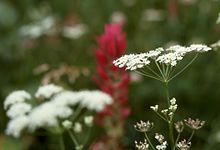Perideridia
This article needs additional citations for verification. (October 2011) |
| Perideridia | |
|---|---|

| |
| Perideridia gairdneri subsp. borealis | |
| Scientific classification | |
| Kingdom: | |
| (unranked): | |
| (unranked): | |
| (unranked): | |
| Order: | |
| Family: | |
| Genus: | Perideridia |
| Species | |
|
About 12; see text. | |
Perideridia is a small genus of plants in the parsley family. Plants in this genus are known generally as yampah or yampa. They are native to western North America. Similar in appearance to other plants belonging to the family Apiaceae, they have umbels of white flowers.
Description
The plants have a unique appearance for members of the parsley family, and are tall (1–3 feet) and grasslike, with threadlike leaves 1–6 inches long that resemble blades of grass. The plants effectively mimic tall grass and are virtually invisible until they flower, since they tend to grow in grassy meadows, and prefer full sunlight. Like most members of the parsley family, yampah produces umbels of white flowers. The small roots of yampah are about the size of a large unshelled peanut.
Distribution and habitat
The plants are widely distributed in moist open meadows and hillsides up to 7,500 feet (2,300 m) across Western North America and Northern Mexico.[1]
Uses
Perideridia gairdneri was an important staple crop of Native Americans in Western North America. The nutlike roots of the plant are crunchy and mildly sweet, and resemble in texture and flavor water chestnuts.
Yampah roots were either baked or steamed, and were reported to have excellent flavor and nutritional qualities. The seeds of yampah were used as a seasoning and resemble caraway seeds in flavor. Yampah roots contain rapidly assimilatable carbohydrates, and were used by hunters and runners as a high energy food to enhance physical endurance.
Uncooked yampah roots are a gentle laxative if consumed in excess and were used medicinally for this purpose.[1]
It resembles the highly toxic poison hemlock and water hemlock.
Selected species
- Perideridia americana – eastern yampah
- Perideridia bacigalupii – Mother Lode yampah, Bacigalupi's yampah
- Perideridia bolanderi – Bolander's yampah
- Perideridia californica – California yampah
- Perideridia erythrorhiza – redroot yampah, western yampah
- Perideridia gairdneri – Gardner's yampah, common yampah, Indian caraway
- Perideridia howellii – Howell's yampah
- Perideridia kelloggii – Kellogg's yampah
- Perideridia lemmonii – Lemmon's yampah
- Perideridia leptocarpa – narrowseed yampah
- Perideridia oregana – Oregon yampah, squaw potato
- Perideridia parishii – Parish's yampah, Sierra Queen Anne's lace
- Perideridia pringlei – adobe yampah
References
- ^ a b Gregory L. Tilford (1997). Edible and Medicinal Plants of the West. Mountain Press Publishing. ISBN 978-0-87842-359-0.
